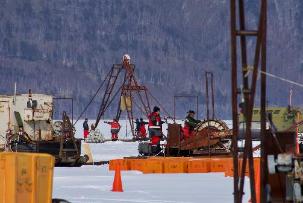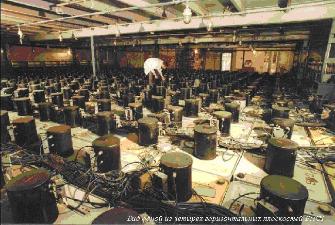Installations
 Baikal Neutrino Observatory INR RAS
Baikal Neutrino Observatory INR RAS
On Lake Baikal (Irkutsk region), the Institute of Nuclear Research of the Russian Academy of Sciences, in collaboration with JINR, has created a unique neutrino telescope, which is part of the Global Neutrino Network (GNN) as the most important element of the network in the Northern Hemisphere of the Earth. The Baikal-GVD neutrino telescope is designed to record and study ultra-high energy neutrino fluxes from astrophysical sources. The effective volume of the installation in the problem of recording shower events from neutrinos is 0.35 km3. Simultaneously with data acquisition, the telescope continues to be expanded to a volume of 1 km3.
Baksan Neutrino Observatory INR RAS
Baksan Neutrino Observatory;village. Neutrino, Kabardino-Balkarian Republic; with a complex of large-scale underground neutrino telescopes and large-area ground-based facilities for research in the fields of solar neutrino physics, cosmic ray physics and neutrino astrophysics. At the Baksan gallium-germanium neutrino telescope, precision measurements were made of the rate of capture of solar neutrinos by gallium nuclei, which, together with the results of a number of other experiments on solar neutrinos, provided unambiguous evidence of the thermonuclear nature of solar energy and led to the discovery of interconversions of (oscillations) neutrinos of various types. Starting from mid-2019, a new experiment, BEST (Baksan Experiment for Sterile Transition), has been conducted. Its goal is to study neutrino oscillations at record-breaking short distances and the possible detection of a new type of neutrino, the so-called sterile neutrino. The Laboratory of Low Background Research has obtained the world's best restrictions on the probability of double K-capture in nuclei 78Kr, 124Xe and double beta decay of a number of elements. The Carpet-3 experiment with the world's largest compact muon detector is aimed at achieving record sensitivity to diffuse gamma radiation with energies above 100 TeV.
 Installation "Troitsk nu-mass"
Installation "Troitsk nu-mass"
Installation for measuring the mass of electron antineutrinos in the beta decay of tritium “Troitsk-nu-mass”. The limit on the neutrino mass obtained at this installation remained the best in the world for 15 years. The Troitsk-nu-mass record was broken in 2019. This was accomplished at the KATRIN facility in Germany with the participation of scientists from the Institute for Nuclear Research (INR RAS). The design of the KATRIN installation is a scaled model of the Troitsk-nu-mass experiment, originally proposed by academician V.M. Lobashev.
More detailed: https://www.inr.ru/~numass/index_eng.html
Linear proton accelerator complex in Troitsk
The most powerful linear proton accelerator in Eurasia, enabling fundamental and applied research in the field of nuclear and neutron physics, condensed matter, development of technologies for the production of a wide range of radioisotopes, operation of a radiation therapy complex and many other applications.
 BNO INR RAS - Laboratory Baksan underground scintillation telescope.
BNO INR RAS - Laboratory Baksan underground scintillation telescope.
The laboratory conducts scientific research on the Baksan scintillation telescope, and on installations for recording extensive atmospheric showers - "COVER" and "ANDYRCHI". Scientific supervision is carried out by Academician G.T. Zatsepin and Doctor of Physical and Mathematical Sciences S.P. Mikheev. Most of the work is carried out jointly with the Department of High Energy Leptons and Neutrino Astrophysics at INR.
